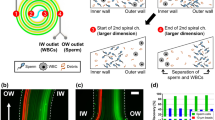Abstract
Infertility studies are an important growing field, where new methods for the manipulation, enrichment and selection of sperm cells are required. Microfluidic techniques offer attractive advantages such as requirement of low sample volume and short processing times in the range of second or minutes. Presented here is the application of insulator-based dielectrophoresis (iDEP) for the enrichment and separation of mature and spermatogenic cells by employing a microchannel with cylindrical insulating structures with DC electric potentials in the range of 200–1500 V. The results demonstrated that iDEP has the potential to concentrate sperm cells and distinguish between mature and spermatogenic cells by exploiting the differences in shape which lead to differences in electric polarization. Viability assessments revealed that a significant percentage of the cells are viable after the dielectrophoretic treatment, opening the possibility for iDEP to be developed as a tool in infertility studies.





Similar content being viewed by others
References
Gur Y, Breitbart H (2006) Mammalian sperm translate nuclear-encoded proteins by mitochondrial-type ribosomes. Genes Dev 20(4):411–416
Hsu S-H, Hsieh-Li H-M, Li H (2004) Dysfunctional spermatogenesis in transgenic mice overexpressing bHLH-Zip transcription factor, Spz1. Exp Cell Res 294(1):185–198
Cui W (2010) Mother or nothing: the agony of infertility. WHO Bull 88(12):881–882
Romrell LJ, Bellvé AR, Fawcett DW (1976) Separation of mouse spermatogenic cells by sedimentation velocity: a morphological characterization. Dev Biol 49:119–131
Voldman J (2006) Electrical forces for microscale cell manipulation. Ann Rev Biomed Eng 8:425–454
Prince M, Ma X, Docker P, Ward M, Prewett P (2007) The development of a novel Bio-MEMS filtration chip for the separation of specific cells in fluid suspension. Proc Inst Mech Eng [H] 221(2):113–128
D-b Seo, Agca Y, Feng Z, Critser J (2007) Development of sorting, aligning, and orienting motile sperm using microfluidic device operated by hydrostatic pressure. Microfluid Nanofluid 3(5):561–570
Lopez-Garcia M, Monson R, Haubert K, Wheeler M, Beebe D (2008) Sperm motion in a microfluidic fertilization device. Biomed Microdev 10(5):709–718
Chen Y-A, Huang Z-W, Tsai F-S, Chen C-Y, Lin C-M, Wo A (2011) Analysis of sperm concentration and motility in a microfluidic device. Microfluid Nanofluid 10(1):59–67
Smith GD, Takayama S (2007) Gamete and embryo isolation and culture with microfluidics. Theriogenology 68:s190–s195
Lapizco-Encinas BH, Simmons BA, Cummings EB, Fintschenko Y (2004) Dielectrophoretic concentration and separation of live and dead bacteria in an array of insulators. Anal Chem 76(6):1571–1579
Lapizco-Encinas BH, Rito-Palomares M (2007) Dielectrophoresis for the manipulation of nanobioparticles. Electrophoresis 28(24):4521–4538
Gagnon ZR (2011) Cellular dielectrophoresis: applications to the characterization, manipulation, separation and patterning of cells. Electrophoresis 32(18):2466–2487
Fuhr G, Muller T, Baukloh V, Lucas K (1998) High-frequency electric field trapping of individual human spermatozoa. Hum Reprod 13(1):136–141
Buoncristiani MR, Timken MD (2009) In: U.S. Department of Justice, p 50
Ohta AT, Garcia M, Valley JK, Banie L, Hsu H-Y, Jamshidi A, Neale SL, Lue T, Wu MC (2010) Motile and non-motile sperm diagnostic manipulation using optoelectronic tweezers. Lab Chip 10(23):3213–3217
Garcia MM, Ohta AT, Walsh TJ, Vittinghof E, Lin GT, Wu MC, Lue TF (2010) A noninvasive, motility independent, sperm sorting method and technology to identify and retrieve individual viable nonmotile sperm for intracytoplasmic sperm injection. J Urol 184(6):2466–2472
Valley JK, Swinton P, Boscardin WJ, Lue TF, Rinaudo PF, Wu MC, Garcia MM (2010) Preimplantation mouse embryo selection guided by light-induced dielectrophoresis. PLoS ONE 5(4):e10160
Jones TB (2003) Basic theory of dielectrophoresis and electrorotation. IEEE Eng Med Biol Mag 22(6):33–42
Srivastava S, Gencoglu A, Minerick A (2010) DC insulator dielectrophoretic applications in microdevice technology: a review. Anal Bional Chem 399(1):301–321
Moncada-Hernández H, Lapizco-Encinas BH (2010) Simultaneous concentration and separation of microorganisms: insulator-based dielectrophoretic approach. Anal Bional Chem 396(5):1805–1816
Gallo-Villanueva RC, Jesús-Pérez NM, Martínez-López JI, Pacheco A, Lapizco-Encinas BH (2011) Assessment of microalgae viability employing insulator-based dielectrophoresis. Microfluid Nanofluid 10(6):1305–1315
Pohl HA (1951) The motion and precipitation of suspensoids in divergent electric fields. J Appl Phys 22(7):869–871
Markx GH, Dyda PA, Pethig R (1996) Dielectrophoretic separation of bacteria using a conductivity gradient. J Biotechnol 51(2):175–180
Kwon J-S, Maeng J-S, Chun M-S, Song S (2008) Improvement of microchannel geometry subject to electrokinesis and dielectrophoresis using numerical simulations. Microfluid Nanofluid 5(1):23–31
Davalos RV, McGraw GJ, Wallow TI, Morales AM, Krafcik KL, Cummings EB, Simmons BA (2008) Performance impact of dynamic surface coatings on polymeric insulator-based dielectrophoretic particle separators. Anal Bional Chem 390(3):847–855
Martínez-López JI, Moncada-Hernández H, Baylon-Cardiel JL, Martínez-Chapa SO, Rito-Palomares M, Lapizco-Encinas BH (2009) Characterization of electrokinetic mobility of microparticles in order to improve dielectrophoretic concentration. Anal Bional Chem 394(1):293–302
Baylon-Cardiel JL, Lapizco-Encinas BH, Reyes-Betanzo C, Chávez-Santoscoy AV, Martínez Chapa SO (2009) Prediction of trapping zones in an insulator-based dielectrophoretic device. Lab Chip 9(20):2896–2901
Jones TB (1995) Electromechanics of particles. Cambridge University Press, USA
Yang CY, Lei U (2007) Quasistatic force and torque on ellipsoidal particles under generalized dielectrophoresis. J Appl Phys 102(9):094702–094711
Hughes MP (2002) Nanoelectromechanics in engineering and biology. CRC Press, Boca Raton, FL
Acknowledgments
The authors would like to acknowledge the financial support provided by CINVESTAV-Monterrey. The authors would like to thank MSc. Hector Moncada-Hernández for support with COMSOL simulations.
Author information
Authors and Affiliations
Corresponding author
Rights and permissions
About this article
Cite this article
Rosales-Cruzaley, E., Cota-Elizondo, P.A., Sánchez, D. et al. Sperm cells manipulation employing dielectrophoresis. Bioprocess Biosyst Eng 36, 1353–1362 (2013). https://doi.org/10.1007/s00449-012-0838-6
Received:
Accepted:
Published:
Issue Date:
DOI: https://doi.org/10.1007/s00449-012-0838-6




